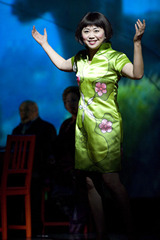| Opera Reviews | 26 April 2024 |
| A
spectacular fusion of east and west by Michael J. Vaughn |
|
| Wallace: The Bonesetter's Daughter San Francisco Opera 16 September 2008 |
|
|
The Prologue, occurring in "a timeless void," features acrobats flying through wild projections of flame and chaos - an introduction so spectacular, in fact, that it tends to muddle the opening storyline. Ruth Young Kamen (mezzo Zheng Cao), a San Francisco ghost writer working on a book about O.J. Simpson, is attempting to negotiate a dinner with her meshuggah Jewish in-laws when her mother, LuLing, has a strange tirade, acting out the O.J. killings in weird, grisly details and then dropping from a stroke. The setting proceeds to the village of Immortal Heart, just outside Beijing, where we find Zheng Cao playing LuLing, sixty years younger, being raised by her Precious Auntie (Qian Yi). As LuLing approaches her wedding day to the coffinmaker Chang (Hao Jiang Tian), Auntie seems particularly focused on the sacrifices she made in child-rearing, describing the day she protected LuLing from a spill of boiling water by catching it in her cupped hands, suffering from the blisters for months after. Stewart Wallace, creator of Harvey Milk, has concocted his own fascinating fusion, backing his operatic singers with percussive Asian strokes that bridge easily to the nasal swoops of Qian Yi's Chinese opera, or kunju, style, and the traditional singing and suona - a shrill Chinese horn - of Wu Tong as the Priest. Wallace has also created a series of memorable set pieces: Ruth's opening aria lamenting her confused childhood, the aforementioned child-rearing memory-piece of Precious Auntie and, most memorably, the chilling aria of Chang as he stalks LuLing in Hong Kong (featuring Hao Jiang Tian's supremely rich bass). Zheng Cao provides the production with a strong central figure (actually, two), Ning Liang with its tragic edge as the older LuLing, but clearly the star is Qian Yi, whose ghostly presence, elegant motions and bewitching kunju singing leave a permanent tattoo on the senses. The same indelible mark is left by Leigh Haas's projections, notably a black-and-white montage of the crowded Hong Kong harbor and the enormous, horrified faces of Auntie's wedding-day intrusion. Much of the credit for the "fusion" aspect of the opera belongs to director Chen Shi-Zheng, who has pretty much guided the creation of an entirely new theatrical sub-genre, and to Tan's highly compressed libretto, which resolves that early murkiness with a second-act revelation breathtaking in its economy. Perhaps the only drawback to Tan's work can be seen in its entirety; a mother-daughter obsession oddly similar to the father-daughter obsession of Verdi in SFO's recent Simon Boccanegra. Through October 3, War Memorial Opera House, 301 Van Ness Avenue, San Francisco. $15-$290, (415) 864-3330, www.sfopera.com. |
|
| Michael J. Vaughn is the author of the opera novel Gabriella's Voice (available at amazon.com) and a twenty-year opera and theater critic. | |
| Text ©
Michael J. Vaughn Photos © Terrence McCarthy |

 If
you believe in opera as the ultimate fusion of the arts, then San Francisco
Opera's production of The Bonesetter's Daughter would be the
ultimate example of that idea. The production is simply spectacular,
using wild visuals, acrobatics and traditional Chinese musical forms
to translate the epic two-continent sweep of Amy Tan's novel.
If
you believe in opera as the ultimate fusion of the arts, then San Francisco
Opera's production of The Bonesetter's Daughter would be the
ultimate example of that idea. The production is simply spectacular,
using wild visuals, acrobatics and traditional Chinese musical forms
to translate the epic two-continent sweep of Amy Tan's novel. 





